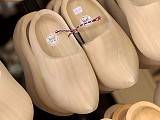Lancashire Clog Dancing Lecture
Date published: 12 October 2004

Lancashire Clog Dancing Lecture
Step back in time for a moment, think of the nineteenth-century cotton mill workers reproducing the sound of their looms. Here was the birth of clog dancing, although there are reportedly citations dating back to the fourteenth century. What we do know is common steps and routines do have names related to weaving actions and equipment!
This local activity eventually inspired national competitions such as the World Clog Dancing Championships; the winner proudly went away with a decoratively tooled leather belt and a substantial monetary prize. During the mid-nineteenth century, street corner dancing, and clog and step dancing at home, became the most popular entertainment of the day.
Now in 2004, there will be a clog-dancing lecture and demonstration on Friday 15 October, at Touchstones Rochdale. This is being given by Chris Metherell, who works with the INSTEP team of researchers and performers of traditional dance forms. So, we get to see the centuries of clog dancing brought back to life at nothing else but the Touchstones. Come and see for yourself how so many years of cotton mills has developed into a skilled dance routine!
The clogs used for dancing were usually lighter and wooden-soled, as opposed to the irons normally seen on the heavy working clogs. Often the uppers were tooled and coloured, as still seen on the clogs of modern traditional dancers who revive and maintain the performances of previous generations. There is a very detailed paper in the 'Transactions of the Rochdale Literary and Scientific Society. XXI (1941-43)' by Mr. R.U. Sayce entitled 'Patterns and Clogs' which makes fascinating reading, and which refers to artefacts held in the Rochdale Museum that it is hoped may be on view at the lecture.
In point of fact, three distinct dance styles were practiced: the principal and predominant style is referred to as 'heel and toe', featuring a very precise pattern of steps; a hybrid style called 'Lancashire-Irish' developed as mills and factories employed immigrant workers; a third style came from the boaters working the local canals, dancing to the beat of the barge engine. Good clog dancers could get away from the poor living conditions and poverty of the factory and mill towns by becoming professional music-hall dancers.
A famous one was Dan Leno, who became a World Champion, and a notable practitioner was Charlie Chaplin who performed in a troupe called the 'Seven Lancashire Lads. It was with such performers that stage clog dancing went out to the colonies, in particular North America where it evolved into a completely new form, namely tap-dancing, which is still going strong to the present day.
Do you have a story for us?
Let us know by emailing news@rochdaleonline.co.uk
All contact will be treated in confidence.
Most Viewed News Stories
- 1Newhey's Char Steakhouse and Bank Chamber close with immediate effect
- 2Six men arrested in Rochdale child exploitation investigation
- 3Royton haulage firm fined after Rochdale dad went to work and didn’t come home
- 4Two men arrested after police chase ends up in Middleton river
- 5Obituary: Jean Ashworth
To contact the Rochdale Online news desk, email news@rochdaleonline.co.uk or visit our news submission page.
To get the latest news on your desktop or mobile, follow Rochdale Online on Twitter and Facebook.


